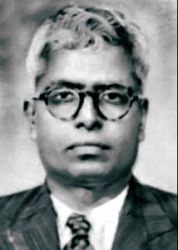S. Sivasankaranarayana Pillai
S. Sivasankaranarayana Pillai ( Subbayya Sivasankaranarayana Pillai; often cited as SS Pillai ; * 1901 in Vallam , Tamil Nadu ; † August 31, 1950 near Cairo ) was an Indian mathematician who is known for his work in number theory .
He worked on the so-called Waring problem , specifically on the determination of precise values of the function g ( n ) ( Leonard Dickson succeeded in a similar way at the same time ). He gave formulas for this, which are reduced to a formula if a certain inequality has no solution (which is still unproven today). He also determined g (6) = 73 in 1940. He also published articles on the theory of Diophantine approximation .
biography
His parents were Subbayya Pillai and Gomati Ammal. His mother died a year after he was born, and he was raised under the care of an old family member. When he was five years old, he was homeschooled by a teacher for three years. When he was nine, he attended a middle school in Shencottah . A teacher at this school named Sastriar became aware of his abilities and continued to support and encourage him.
Pillai later moved to the local high school for his matriculation course . After the sudden death of his father, he had financial difficulties to continue his high school education. His former teacher Sastriar supported him financially, both for his graduation and in the time afterwards. He went to Nagercoil to take a scholarship class at Scott Christian College . He then did his bachelor's degree in Trivandrum at Maharajas College .
In 1927, Pillai received a research fellowship from the University of Madras to work under Professors K. Ananda Rau and R. Vaidyanathaswamy . Then he was from 1929 to 1941 at Annamalai University in Annamalai Nagar ( Cuddalore (district) ), where he was a lecturer and received a doctorate (D. Sc.) For his mathematical research. Pillai was the first there to receive this award in mathematics. In 1941 he went to the University of Travancore and a year later to the University of Calcutta as a lecturer (where he was at the invitation of Friedrich Wilhelm Levi ).
For his achievements, Sivasankaranarayana Pillai was invited to visit the Institute for Advanced Studies , Princeton (USA) for one year in 1950/51 . He was also invited to participate in the International Congress of Mathematicians at Harvard University as a delegate from Madras University. He flew to the United States in August 1950 and was killed in a plane crash near Cairo.
Pillai conjecture
An unsolved conjecture named after him says that the distances between powers of natural numbers diverge and only assume a certain integer value in a finite number of cases. In 1931 he assumed more generally that for fixed positive integers A , B , C the equation only has a finite number of solutions ( x , y , m , n ) with ( m , n ) ≠ (2,2). The latter assumption follows from the abc assumption .
See also
swell
- SS Pillai. An Outstanding Indian Number Theorist. ( Memento from August 20, 2007 in the Internet Archive )
- An outstanding mathematician at thehindujobs.com
Individual evidence
- ^ Raghavan Narasimhan The coming of age of mathematics in India , in Michael Atiyah et al. a. Miscellanea Mathematica , Springer Verlag 1991, p. 250f
| personal data | |
|---|---|
| SURNAME | Pillai, S. Sivasankaranarayana |
| ALTERNATIVE NAMES | Pillai, Subbayya Sivasankaranarayana (full name); Pillai, SS |
| BRIEF DESCRIPTION | Indian mathematician |
| DATE OF BIRTH | 1901 |
| PLACE OF BIRTH | Vallam , Tamil Nadu , India |
| DATE OF DEATH | August 31, 1950 |
| Place of death | near Cairo , Egypt |

